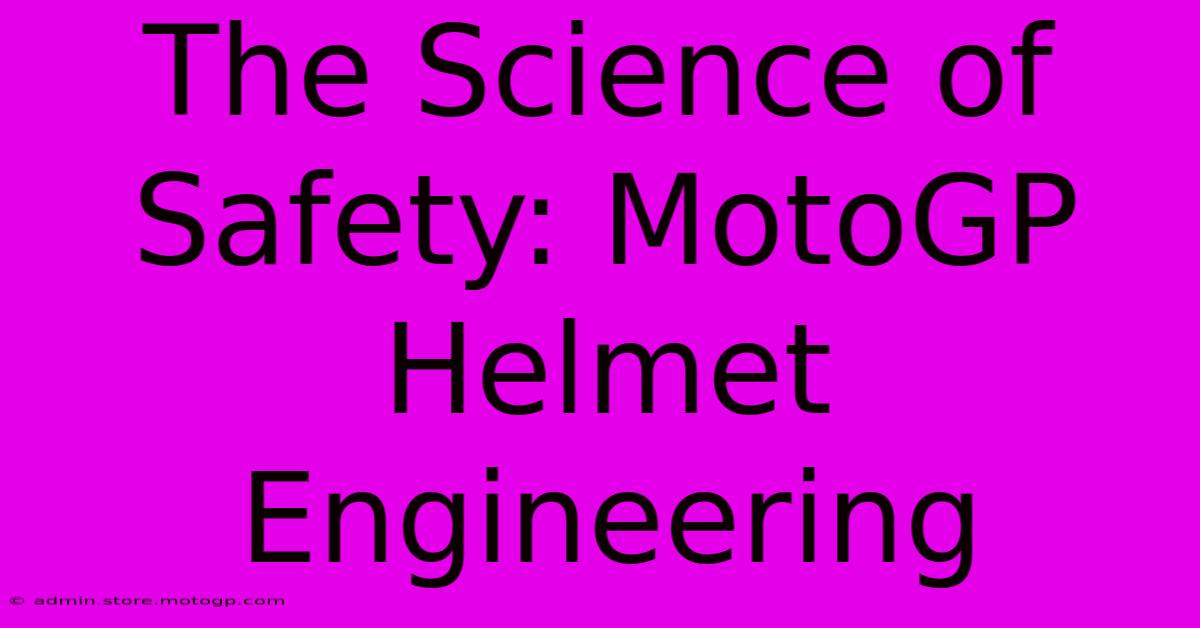The Science Of Safety: MotoGP Helmet Engineering

Table of Contents
The Science of Safety: MotoGP Helmet Engineering
The roar of the engines, the blur of speed, the breathtaking maneuvers – MotoGP racing is a spectacle of skill and daring. But behind the adrenaline-fueled spectacle lies a crucial element often overlooked: safety. And at the heart of rider safety is the engineering marvel that is the MotoGP helmet. This isn't just any helmet; it's a sophisticated piece of technology designed to withstand unimaginable forces. Let's delve into the science behind these life-saving pieces of equipment.
The Uncompromising Demands of MotoGP Helmet Design
MotoGP helmets face extreme conditions unlike any other. Riders experience G-forces many times their body weight during crashes, impacts at high speeds, and constant exposure to debris and extreme weather. Therefore, the design and construction must be uncompromising. Here's a breakdown of the key elements:
1. Shell Construction: A Fortress of Protection
The outer shell is typically made from carbon fiber, Kevlar, or a composite blend of materials. These materials offer an exceptional strength-to-weight ratio, crucial for minimizing weight without sacrificing protection. The shell's design is meticulously engineered using finite element analysis (FEA) to distribute impact forces efficiently, preventing penetration and reducing the risk of skull fractures.
2. Liner Technology: Absorbing the Impact
The inner liner is where the real magic happens. Modern MotoGP helmets utilize multi-density EPS (expanded polystyrene) liners. Different densities of EPS are strategically placed to absorb varying levels of impact energy. A softer density absorbs lower energy impacts, while a firmer density manages higher energy collisions. This layered approach ensures optimal shock absorption across a spectrum of impact forces.
3. Advanced Visor Technology: Clear Vision, Enhanced Safety
The visor isn't just a clear window; it's a crucial safety component. Polycarbonate visors, known for their optical clarity and impact resistance, are standard. Many helmets feature visors with anti-fog and anti-scratch coatings, ensuring optimal visibility even in challenging conditions. Some incorporate tear-off systems for quick visor cleaning during races. The visor's mechanism is rigorously tested to ensure it remains securely fastened even under extreme impact.
4. Ventilation and Comfort: Maintaining Performance
While protection is paramount, comfort and ventilation are also vital. Effective ventilation systems help regulate the rider's temperature, preventing overheating and maintaining focus. Strategically placed vents and channels within the helmet's shell and liner work together to provide optimal airflow. The internal lining is typically made from hypoallergenic and moisture-wicking fabrics, enhancing comfort and preventing chafing during long races.
Beyond the Basics: Cutting-Edge Innovations
Helmet technology is constantly evolving. Manufacturers are continuously pushing the boundaries of safety with innovations like:
- Improved Impact Absorption Materials: Research into new materials promises even better shock absorption capabilities.
- Advanced Sensor Technology: Integrated sensors can monitor impact forces, providing valuable data for further helmet improvements and injury analysis.
- Enhanced Aerodynamics: Optimized shell designs minimize wind resistance and enhance stability at high speeds.
Conclusion: A Testament to Engineering Excellence
The MotoGP helmet is more than just head protection; it's a testament to the dedication to safety in this high-risk sport. The science and engineering behind these helmets continually evolve, pushing the boundaries of protective technology and ensuring that riders have the best possible chance of surviving even the most catastrophic crashes. The relentless pursuit of safety in MotoGP helmet design underlines the commitment to protecting the lives of these courageous athletes.

Thank you for visiting our website wich cover about The Science Of Safety: MotoGP Helmet Engineering. We hope the information provided has been useful to you. Feel free to contact us if you have any questions or need further assistance. See you next time and dont miss to bookmark.
Featured Posts
-
Dont Miss Out Austin Gp Sprint Race Action
Feb 18, 2025
-
Famous Motorcycle Riders Impact On Motorcycle Design
Feb 18, 2025
-
Moto Gp Speed The Ultimate Adrenaline Rush
Feb 18, 2025
-
Circuit Racing A Passion For Speed
Feb 18, 2025
-
Sprint Race Showdown Moto Gp Results That Matter
Feb 18, 2025
